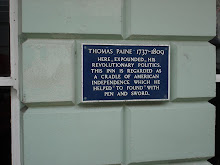


Lewes - although but a short distance from the questionable beauties of New Anzac is culturally, architecturally and socially on another planet. The beautiful county town of East Sussex has, since the founding of nearby Sussex University, become home to a sort of intellectual upper middle class. Despite this it has an underpinning of anarchy in the form of the famous bonfire celebrations and their associated societies and also a deep-rooted radicalism. Arguably Britain's greatest radical, Tom Paine was an exciseman here and debated his influential politics in the historic White Hart Inn - a plaque outside commemorates his influence and records the part he played in the establishment of American independence.
Lewes abounds with pubs, the best of which are fed by the town's brewery and lynchpin, Harveys. It also has some interesting shops...avoid the usual 'one candle and a bolt of bleached linen' designer-homes variety of which the town has its share and instead head for Messrs Hugh Rae, Gentlemens Outfitters where you may purchase regimental or squadron blazer buttons to complete the caddish look. Why not buy a cravat? there's a range of paisley and military designs from which to choose. Or a very nice line in Tattersall check shirts. Trilby hats, Panamas, and Deer Stalkers are the favourites here along with those camel coats with velvet collars so beloved of the racing fraternity. Should clothing not be on your agenda, there's Catlin's just along the road - a proper tobacconist selling the substance in all its infinite variety from cigars, to cigarettes, to loose pipe tobacco to snuff. For all I know 'RedMan' chewing tobacco may be offered illicitly but I doubt it, the pavements give no evidence. Choose a pipe, or a cigarette holder, a tobacco pouch or a cigar cutter, indeed all the impedimenta of smoking, all the stuff that makes it so satisfying, and it's there just for you. However, if like me you are a lapsed smoker you cannot help but be seduced by the smells and packaging and remember the days. I no longer smoke but I still find the scent from a freshly opened jar of pipe tobacco absolutely heavenly. One glimpse of an old packet of 'Paffing Cloud', 'Gold Flake' (my favourite) or even 'Nelson' gets me coughing with excitement. She's a cruel mistress, tobacco, but to assuage your guilt you could pretend you were nipping into Catlin's for a bar of chocolate...








